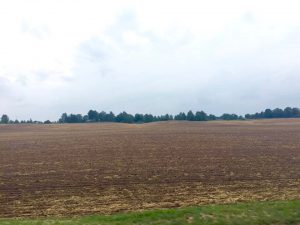At one point forecasts seem to suggest that today would offer decent soaring (which no doubt most here would welcome). It was not to be: rain began around 8:30, was strong by 9:00, tapered off by 9:30 but persisted for several hours. With some short breaks, overcast persisted all day.
By late afternoon it looked as if we might be able to assemble gliders for the technical inspection (known as “scrutineering”) that all gliders must undergo before the start of competition. As we were putting wings on, word came of severe weather headed toward Pociunai, said to consist of 50-knot winds and damaging hail. Gliders promptly retreated into their trailers.
The worst weather stayed north of here – folks shopping in the city of Kaunas (30 km north; home to some truly first-rate stores) reported wind, rain and hail sufficient to make driving difficult. The threat passed with little more than rain, but all enthusiasm for doing anything with gliders was gone. We hold out hope for tomorrow, the final practice day.
Some random observations from a week in southern Lithuania:
We’re a long way north here – at a latitude about the same as Ketchikan, Alaska. Though a month past the summer solstice, we get an early sunrise and late sunset (with a notably long period of twilight).
Despite a per-capita income rather low by European standards ($15,000 – about a third of Germany’s) Lithuania seems generally a modern, prosperous country. Shops are well stocked with pretty much the same goods you’d expect in any western country (with prices that are notably attractive).
A store teller’s cash “drawer” will nearly always be a rectangular metal box with a hinged lid, containing compartments for bills of all Euro denominations, which rest on their long edges, not flat. Nearby will always be a square glass dish where a customer places cash and receives change. You’re expected to bring your own bags, or pay a small amount for plastic ones.
Agriculture consists of largeish fields in which are grown barley, wheat, rye, oats, canola (knows outside the US as rapeseed) and others. Pastures tend to be lumpy – enough so to rank as dubious choices for glider landings. You frequently see a single cow tied to a stake with a 20-ft tether (she is presumably moved every day). Horse drawn carts, though not common, are occasionally seen.
One fairly common sight near a town of any size is one or more large & soulless brick buildings, long abandoned and moldering away, perhaps with trees emerging from the windows. These are former apartment blocks built during the Soviet era, for which little use – or affection – can be found today.
A few details seem curious:
• Despite a healthy insect population (which certainly includes mosquitos), screens are not popular on doors or windows. (Indeed, I think we’ve yet to discover the first example.)
• Most doors lock with a key both from the inside and outside. This includes bedroom & bathroom doors. Why you’d want to be able to remove the key (possibly making it hard to get out) from your bathroom door is a mystery.
• Light switches are commonly located outside a room’s door. It’s thus presumably a popular juvenile prank to switch off the light in an occupied bathroom.
John Good
Some area fields pix from Mike and Mitch






Thanks John. The John Good Report is much appreciated (or anxiously awaited!) by supporters back home. Best of luck to Team USA and wishing you lots of sun and racing.
John,
You are such a great wordsmith!
A great read
George UU